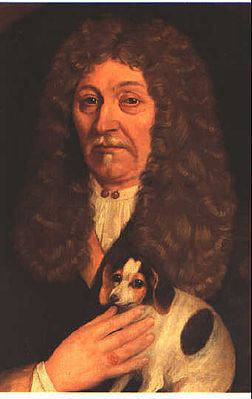Name Henry Bishop Role Postmaster general | Died 1691 | |
 | ||
Henry Bishopp, (1611–1691/2), also spelt Bishop and Bisshopp, from Henfield in Sussex, England was a Postmaster General of England and inventor of the first postmark used on mail. He was the second son of Sir Thomas Bishopp, 1st Baronet of Parham in Sussex. Henry at first fought for King Charles I, but was reconciled with parliament in 1647, after spending two years in Virginia. In the meantime his Rectory estate in Henfield had been sequestered. However, he was restored to royal favour in 1660 and served as postmaster-general between that date and 1663. At his death in 1692 (N.S.) his Rectory estate in Henfield passed to his great-nephew Sir Cecil Bishopp, 4th Baronet.
Contents

Postmaster General
Before the creation of the position of Postmaster General, control of the post was in the hands of "Master of the King's Post". In 1660, at The Restoration, Henry Bishop paid £21,500 per year to farm the Post Office for a term of seven years. This was more than double the previous payment. Bishop's letters patent gave him the monopoly to carry letters within the kingdom. His appointment was to start on 25 June 1660, but was delayed until 29 September when the Act of Parliament reconstituted the General Post Office. Bishop claimed no less than £500 in compensation for the loss of income because several independent posts had been started between London and the country but were not suppressed until the act was passed; they infringed on his monopoly to carry letters.
Bishop was the first officially appointed Postmaster General to Charles II but within a year of taking office he was accused of abuses. In reply, he mentions the improvements he instigated including the stamping of letters, on 2 August 1661. He served in the position until April 1663 at which time he gave up the remainder of his lease to Daniel O'Neill.
Bishop mark
Henry Bishop introduced the world's first known postmark that takes his name in 1661. The "Bishop Mark" was designed to show the date on which a letter was received by the post and to ensure that the dispatch of letters would not be delayed. These were the world's first handstruck postage stamps
Bishop announced,
The postmarks were usually on the back of the letter and are known initially used in the Chief Office in London but were introduced later in Dublin, Edinburgh and New York City.
The original London Bishop Mark, first used 19 April 1661 consisted of a small circle of 13 mm diameter, bisected horizontally, with the month (in serifed lettering) abbreviated to two letters, in the upper half and the day of the month in the lower half. Similar marks were used later in Scotland and Ireland, as well as the North American colonies.
In 1673, a new mark was brought into use which had a diameter of between 13 and 14 mm. The type used from this point was sans-serif and this continued in use until 1713. In 1713, larger handstamps were introduced which ranged in size from 14 to 20 mm. The layout of these was also changed, with the month appearing at the base. This type remained in use until 1787, when it was replaced by the double circle type.
